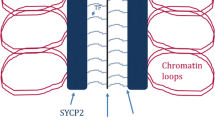Abstract
Only five synaptonemal complexes (SC), representing the 5 autosomes, are present in wild-type, him-4 and him-8, Caenorhabditis elegans males, whereas there are six SCs, accounting for 5 autosomal bivalents and the XX bivalent, in the C. elegans hermaphrodite. The univalent X chromosome of the male is present as a heterochromatic ‘X-body’ in spermatocyte pachytene nuclei. The XX bivalent in wild-type, him-4 and him-8 hermaphrodites (SC1, 2.5 μm in length) represented 6% of the total karyotype length and a SC of this size is missing from the respective male karyotypes. This corresponds with the fact that the total male karyotype length is only approximately 94% that of the hermaphrodite. Associated with the central element of the SC are structures termed ‘SC knobs’ that were first described in the wild-type hermaphrodite. The six SC knobs present in the wild-type hermaphrodite oocyte pachytene nuclei and the two SC knobs in the male spermatocyte pachytene nuclei are apparently randomly placed with the exception that they are never found at the ends of the SC. This is also true in him-4 and him-8 in which case there are 3 and zero SC knobs in the hermaphrodites, respectively, and one SC knob each in the male pachytene nuclei. The decrease in number of SC knobs in hermaphrodite to male represents a true sex difference. The presence or absence of the SC knobs may influence the X chromosome nondisjunction process and this effect is not localized to the region of the SC on which the SC knob is located.
Similar content being viewed by others
References
Baker, B., Hall, J.C.: Meiotic mutants: Genetic control of meiotic recombination and chromosome segregation. In: The genetics and biology of Drosophila (M. Ashburner and E. Novitski eds.) vol. IA, New York: Academic Press 1976
Bogdanov, Yu. F.: Formation of cytoplasmic synaptonemal-like polycomplexes at zygotene in Ascaris suum male meiosis. Chromosoma (Berl.) 61, 1–21 (1977)
Carpenter, A.T.C.: Synaptonemal complexes and recombination nodules in wild-type Drosophila melanogaster females. Genetics 92, 511–541 (1979)
Carpenter, A.T.C.: EM autoradiographic evidence that DNA synthesis occurs at recombination nodules during meiosis in Drosophilia melanogaster females. Chromosoma (Berl.) 83, 59–80 (1981)
Gillies, C.B.: The relationship between Synaptonemal complexes, recombination nodules and crossing over in Neurospora crassa bivalents and translocation quadrivalents. Genetics 91, 1–17 (1979)
Goldstein, P.: Spermatogenesis and spermiogenesis in Ascaris suum. J. Morph. 154, 317–338 (1977)
Goldstein, P.: Ultrastructural analysis of sex determination in Ascaris suum. Chromosoma (Berl.) 66, 59–69 (1978)
Goldstein, P.: Sex determination in nematodes. In: Plant parasitic nematodes B. Zuckerman and R. Rhode eds.), vol. III. New York: Academic Press 1981
Goldstein, P., Moens, P.B.: Karyotype analysis of Ascaris suum male and female pachytene nuclei by 3-D reconstruction from electron microscopy of serial sections. Chromosoma (Berl.) 58, 101–111 (1976)
Goldstein, P., Slaton, D.E.: The synaptonemal complexes of Caenorhabditis elegans: Comparison of wild-type and mutant strains and pachytene karyotype analysis of wild-type. Chromosoma (Berl), 84, 585–597 (1982)
Goldstein, P., Triantaphyllou, A.C.: Occurrence of synaptonemal complexes and recombination nodules in a meiotic race of Meloidogyne hapla and their absence in a mitotic race. Chromosoma (Berl.) 68, 91–100 (1978a)
Goldstein, P., Triantaphyllou, A.C.: Karyotype analysis of Meloidogyne hapla by 3-D reconstruction of synaptonemal complexes from electron microscopy of serial sections. Chromosoma (Berl.) 70, 131–139 (1978b)
Goldstein, P., Triantaphyllou, A.C.: Karyotype analysis of the plantparasitic nematode Heterodera glycines by electron microscopy. I. The diploid. J. Cell Sci. 40, 171–179 (1979)
Goldstein, P., Triantaphyllou, A.C.: Karyotype analysis of the plantparasitic nematode Heterodera glycines by electron microscopy. II. The tetraploid and an aneuploid hybrid. J. Cell Sci. 43, 225–237 (1980)
Goldstein, P., Triantaphyllou, A.C.: Pachytene karyotype analysis of tetraploid Meloidogyne hapla females by electron microscopy. Chromosoma (Berl.) 84, 405–412 (1981)
Hirsh, D.C., Oppenheim, D., Klass, M.: Development of the reproductive system of Caenorhabditis elegans. Dev. Biol. 49, 200–219 (1976)
Hodgkin, J., Horvitz, H.R., Brenner, S.: Nondisjunction mutants of the nematode Caenorhabditis elegans. Genetics 91, 67–94 (1979)
Holm, P.B., Rasmussen, S.W., Wettstein, D. von: The possible contribution of electron microscopy to the understanding of the mechanism of nondisjunction in man. Mutation Res. 61, 115–119 (1979)
Holm, P.B., Rasmussen, S.W.: Chromosome pairing, recombination nodules and chiasma formation in diploid Bombyx males. Carlsberg Res. Commun. 45, 483–548 (1980)
Holm, P.B., Rasmussen, S.W.: Chromosome pairing, crossing over, chiasma formation and disjunction as revealed by 3-D reconstructions. In: International cell biology (H.G. Schweiger, ed.) Berlin: Springer-Verlag 1981
Holm, P.B., Rasmussen, S.W., Zickler, D., Lu, B.C., Sage, J.: Chromosome pairing, recombination nodules and chiasma formation in the Basidiomycete Coprinus cinereus. Carlsberg Res. Commun. 46, 305–346 (1981)
Nigon, V., Brun, J.: L'evolution des structures nucleaires dans l'ovogenese de Caenorhabditis elegans. Maupas 1900. Chromosoma (Berl.) 7, 129–169 (1955)
Rasmussen, S.W.: The meiotic prophase in Bombyx mori females analysed by 3-D reconstruction of synaptonemal complexes. Chromosoma (Berl.) 54, 245–293 (1976)
Rasmussen, S.W., Holm, P.B.: Human meiosis II. Chromsome pairing and recombination nodules in human spermatocytes. Carlsberg Res. Commun. 43, 275–327 (1978)
Rose, A.M., Baillie, D.L.: The effect of temperature and parental age on recombination and nondisjunction in Caenorhabditis elegans. Genetics 92, 409–418 (1979)
Westergaard, M., Wettstein, D. von: Studies on the mechanism of crossing over IV. The molecular organization of the synaptonemal complex in Neotilla. C.R. Trav. Lab. Carlsberg 37, 239–268 (1970)
Wolf, N., Hirsh, D., McIntosh, J.R.: Spermatogenesis in males of the freeliving nematode Caenorhabditis elegans. J. Ultrastr. Res. 63, 155–169 (1978)
Zickler, D.: Development of the synaptonemal complexes and the “recombination nodules” during meiotic prophase in the seven bivalents of the fungus Sordaria macrospora. Chromosoma (Berl.) 61, 289–316 (1977)
Author information
Authors and Affiliations
Rights and permissions
About this article
Cite this article
Goldstein, P. The synaptonemal complexes of Caenorhabditis elegans: pachytene karyotype analysis of male and hermaphrodite wild-type and him mutants. Chromosoma 86, 577–593 (1982). https://doi.org/10.1007/BF00330128
Received:
Issue Date:
DOI: https://doi.org/10.1007/BF00330128




